Deer are beautiful animals that deserve a hearty snack, but not from your garden. Planting flowers they don’t like is an easy way to keep deer away. We’ve compiled a handy list of 11 deer-resistant annual flowers that the does decline and bucks rebuff. Plus, we’ll look at some easy tips for creating a deer-resistant garden, like using strong scents to discourage deer from coming near your beautiful plants.
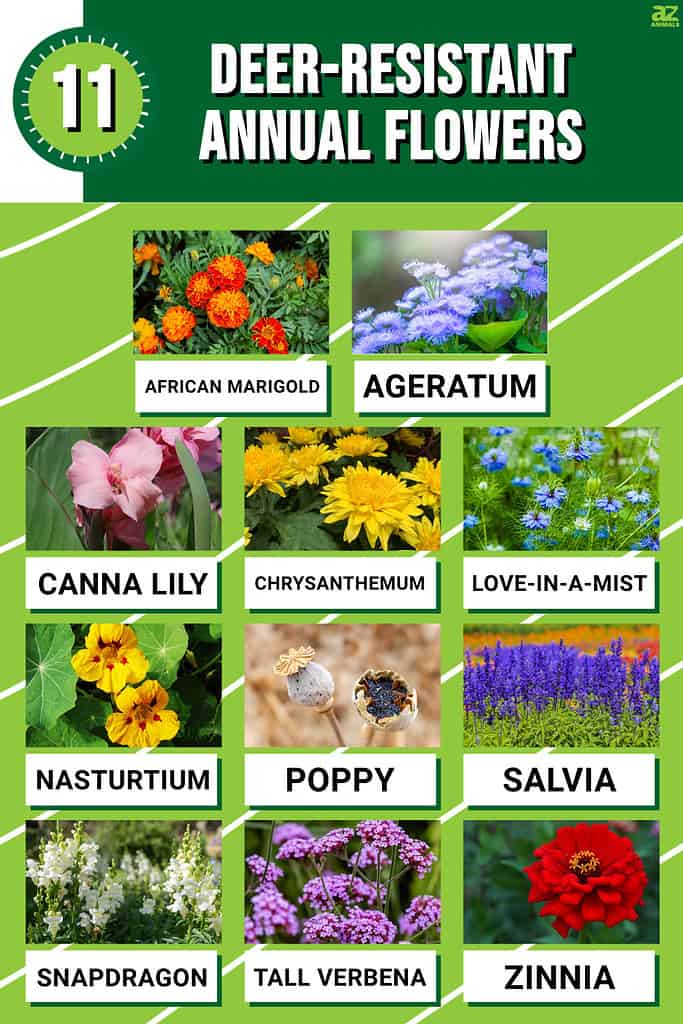
As a general rule, our list of deer-resistant annual flowers are ones that deer avoid for at least one of the following reasons:
- The plants have a spicy or bitter taste.
- The foliage is hard to chew or feels unpleasant in the mouth because it is prickly, hairy, etc.
- The plants have a strong aroma that deer don’t like.
- Certain plants or plant varieties are toxic to deer and other animals.
1. African Marigold

The strong smell of marigolds makes deer avoid them.
©FunFamilyRu/Shutterstock.com
Botanical name: Tagetes erecta
Common names: African marigold, marigold, Aztec marigold
USDA hardiness zones: 2 to 11
Sun exposure: Full sun
Mature size: Up to 4 feet tall, 2 feet wide
Bloom time: Summer to fall
Flower colors: Orange, red, yellow
Easy to grow African marigolds are beautiful annual flowers that deer tend to avoid. Deer and many garden pests don’t like the strong citrus scent of this flower, so they won’t want to linger near it. But African marigolds are beloved by gardeners for their sweet fragrance, pom-pom blooms, and warm colors.
Planting African marigolds in your vegetable garden might also help repel deer from your crops. This planting method is called intercropping and is an alternative to pesticides. In addition to African marigolds, most marigolds are deer-repelling plants, including French and Signet marigolds.
Quick tips for growing African marigolds:
- Watering needs: water African marigolds often for moist soil that’s not soggy.
- Soil type: plant these marigolds in moderately fertile and well-drained soil
- Fertilizing: regular fertilizing is not needed
- Pruning: regularly remove spent blooms (deadheading) to grow more African marigold blooms.
2. Ageratum
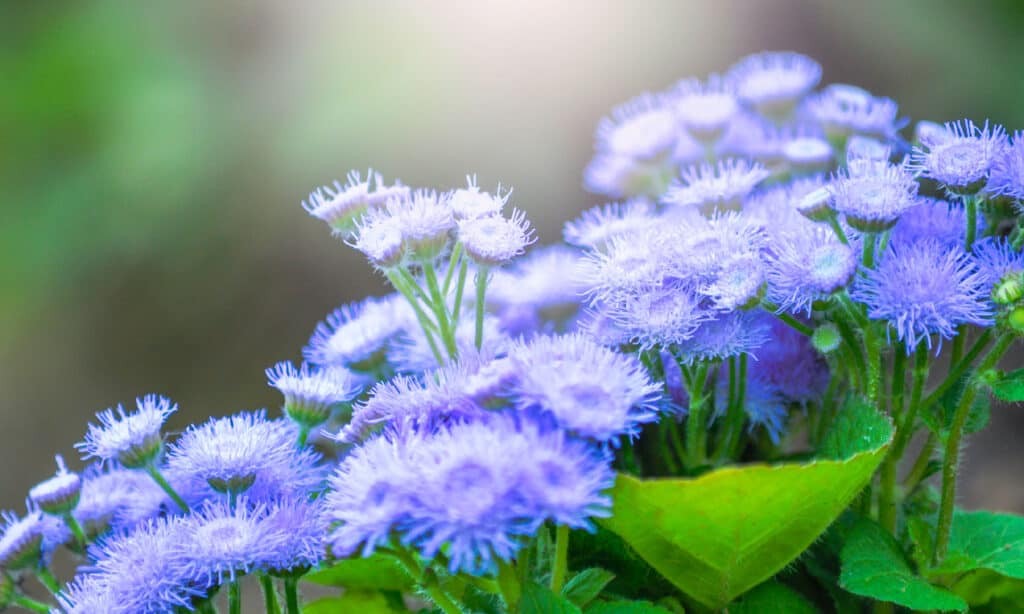
Deer avoids a garden bed full of floss flowers.
©undefined undefined/Shutterstock.com
Botanical name: Ageratum houstonianum
Common names: Floss flower
USDA hardiness zones: 2 to 12
Sun exposure: Full sun or spatial shade
Mature size: Up to 12 inches tall, 12-inches wide
Bloom time: Spring through fall
Flower colors: Lavender, blue, white, pink
Ageratum, also known as floss flower, is a beautiful annual that produces blue, purple, or white round and fluffy pom-pom flowers. Like African Marigolds, ageratums have a sweet scent that people love, but deer don’t! So deer will avoid garden beds full of floss flowers. As a bonus, rabbits don’t like the smell of ageratums either.
It’s important to note that ageratums have short roots, so these deer-resistant annual flowers dry out quickly. Therefore, regular watering is essential to support your healthy plants.
Quick tips for growing ageratums:
- Watering needs: water ageratums at the roots (not from overhead) and don’t let the soil get too dry or soggy.
- Maintenance: ageratums are heat-tolerant and also do fine with light shade, but be sure to allow for good air circulation when planting.
- Garden pests: watch for mites, whiteflies, thrips, and aphids, as these garden pests all love to snack on floss flowers.
- Common diseases: ageratums develop powdery mildew if overwatered.
3. Canna Lily
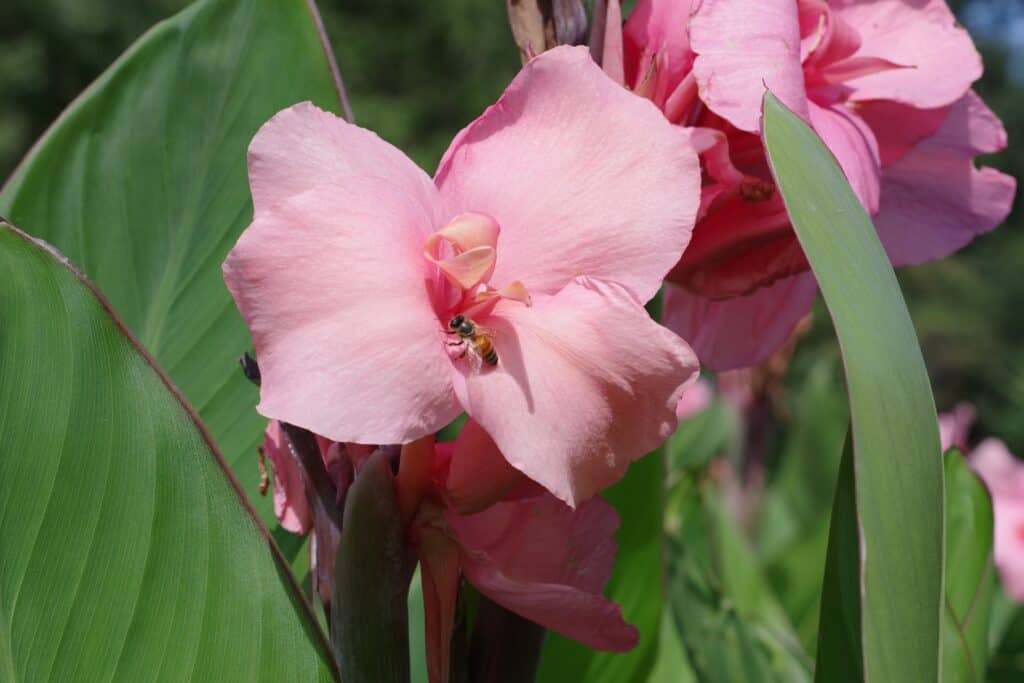
Canna lilies are not true lilies.
©Denise Lynne/Shutterstock.com
Botanical name: Canna x generalis
Common names: Canna lily, canna, Garden canna
USDA hardiness zones: 7 to 11
Sun exposure: Full sun
Mature size: Up to 6 feet tall and 2 feet wide
Bloom time: Late spring through summer
Flower colors: Yellow, orange, red, pink, white, variegated
With their huge, tropical-looking leaves and showy flowers, cannas are a deer-resistant annual that makes a statement in the garden! Canna lilies are not true lilies, but they’re still deer-resistant plants that make your garden look like a paradise. And while deer don’t like cannas, these big beautiful flowers attract pollinators like bees and hummingbirds.
Take note that mature canna plants (which grow up to 6 feet tall) are more deer-resistant than young plants because mature plants are more challenging for deer to chew. So it’s best to protect young canna lilies with netting or deer repellant spray until the plants mature.
The trick to getting cannas to produce their glorious blooms is to ensure they have at least six hours of bright sun every day. They’re also reasonably drought-tolerant, so you don’t have to worry about overwatering them. Make sure the soil drains well, as cannas will rot in soggy conditions.
Cannas are herbaceous perennial flowers in zones 7-11 but grow as annual flowers everywhere else.
Quick tips for growing canna lilies:
- Watering needs: keep canna soil slightly moist and don’t overwater.
- Maintenance: canna bulbs thrive in soil with lots of organic matter.
- Garden pests: aphids, Japanese beetles, snails, and slugs are all attracted to canna plants
- Common diseases: aster yellows is a common disease for cannas, as are bacterial blight, leaf spot, and rust.
4. Chrysanthemum
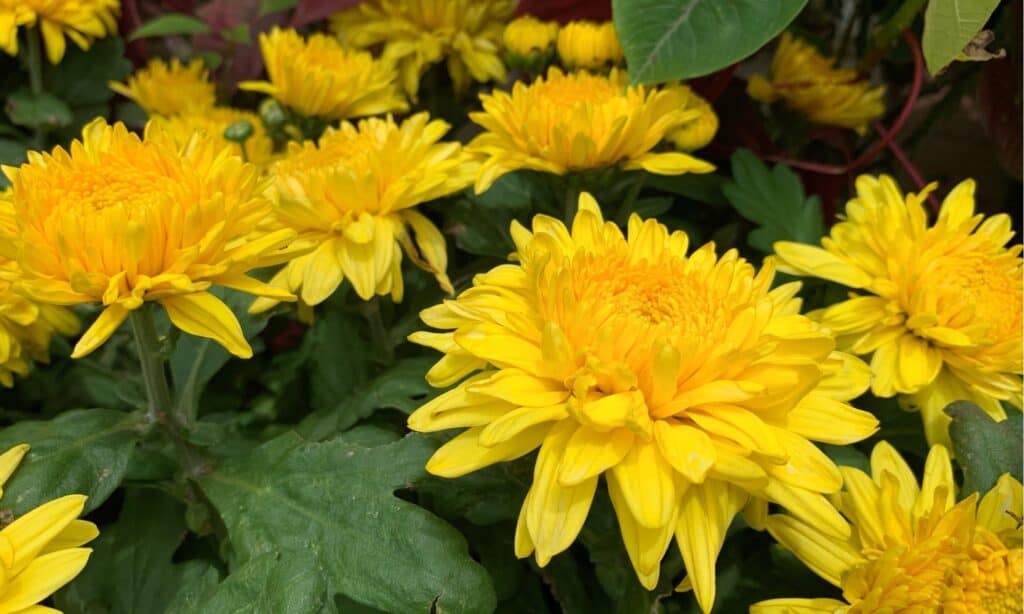
The scent of chrysanthemums repels deer.
©iStock.com/Lanywati Lanywati
Botanical name: Chrysanthemum x morifolum
Common names: Mum, garden mum, florist’s daisy
USDA hardiness zones: 5 to 9
Sun exposure: Full sun preferred
Mature size: Up to 3 feet tall, 2 feet wide
Bloom time: Fall
Flower colors: Pink, orange, yellow, green, white, purple
Aromatic chrysanthemums or mums repel deer because of their scent. Other animals that avoid chrysanthemums include rabbits and perhaps some neighborhood cats who view garden beds as nature’s litter box.
If you’re looking for deer-resistant ground cover, try planting a carpet of mums. Chrysanthemums grow in round mounds, spread quickly, and produce a thick mass of blooms. Just give them plenty of room to spread since they can get quite large!
Deer-resistant mums are herbaceous perennials grown as annual flowers in many parts of the country.
Quick tips for growing chrysanthemums:
- Watering needs: mums need fertile, moist soil.
- Maintenance: give chrysanthemums plenty of airflow and room to grow.
- Garden pests: aphids, spider mites, thrips, and whiteflies are attracted to chrysanthemums
- Common diseases: aster yellows, leaf spot, powdery mildew, and root rot are common mum diseases.
5. Love-in-a-Mist
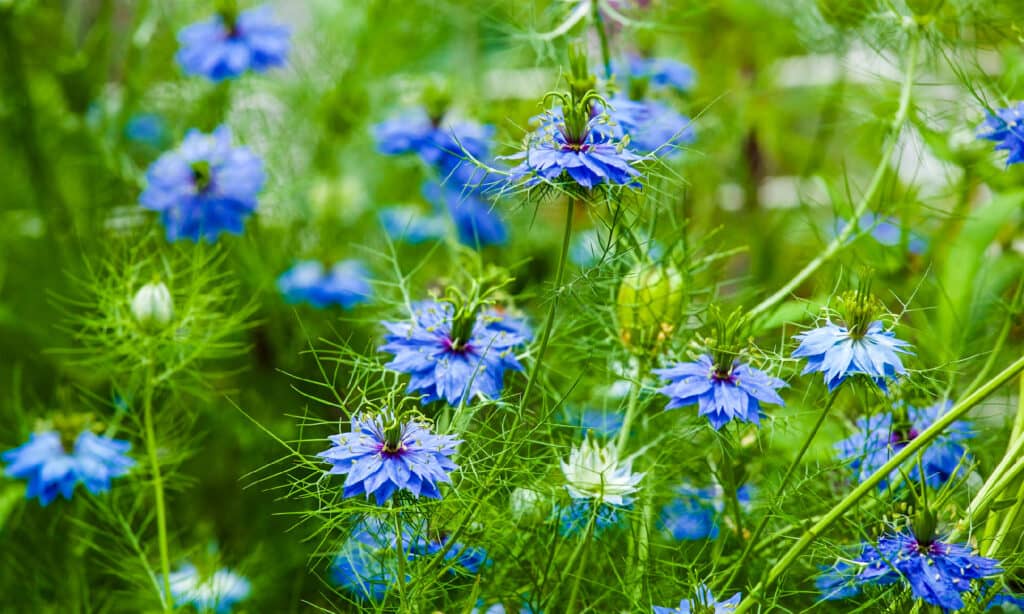
Love-in-a-mist is a favorite of bees, butterflies, and other pollinators.
©iStock.com/Billy_Fam
Botanical name: Nigella damascena
Common name: Love-in-a-mist, devil-in-a-bush, garden fennel
USDA hardiness zones: 2 to 11
Sun exposure: Full sun
Mature size: 12 to 24 inches tall and wide
Bloom time: Summer
Flower colors: Blue, lavender, pink, white
Love-in-a-mist is a deer-resistant annual flower that’s perfect for cottage gardens. It has a romantic, old-fashioned feel with fennel-like foliage creating the illusion of mist around the plant’s blooms.
With dainty flowers topped with a prominent cluster of stamens, love-in-a-mist is a favorite of bees, butterflies, and other pollinators. Love-in-a-mist flowers often come in shades of blue, but cultivars in lavender, pink, and white are also available.
While love-in-a-mist is technically an annual flower, it self-seeds readily, so you may find that it comes back year after year in warmer growing zones.
Quick tips for growing love-in-a-mist:
- Watering needs: love-in-a-mist is drought tolerant once established, so once-weekly watering is fine in most cases.
- Maintenance: love-in-a-mist doesn’t require much maintenance, although you may want to deadhead the spent blooms to prevent self-seeding.
- Garden pests: slugs and snails love to munch on the young leaves.
- Common diseases: love-in-a-mist is relatively disease resistant, but it can develop powdery mildew if the foliage remains too wet.
6. Nasturtium
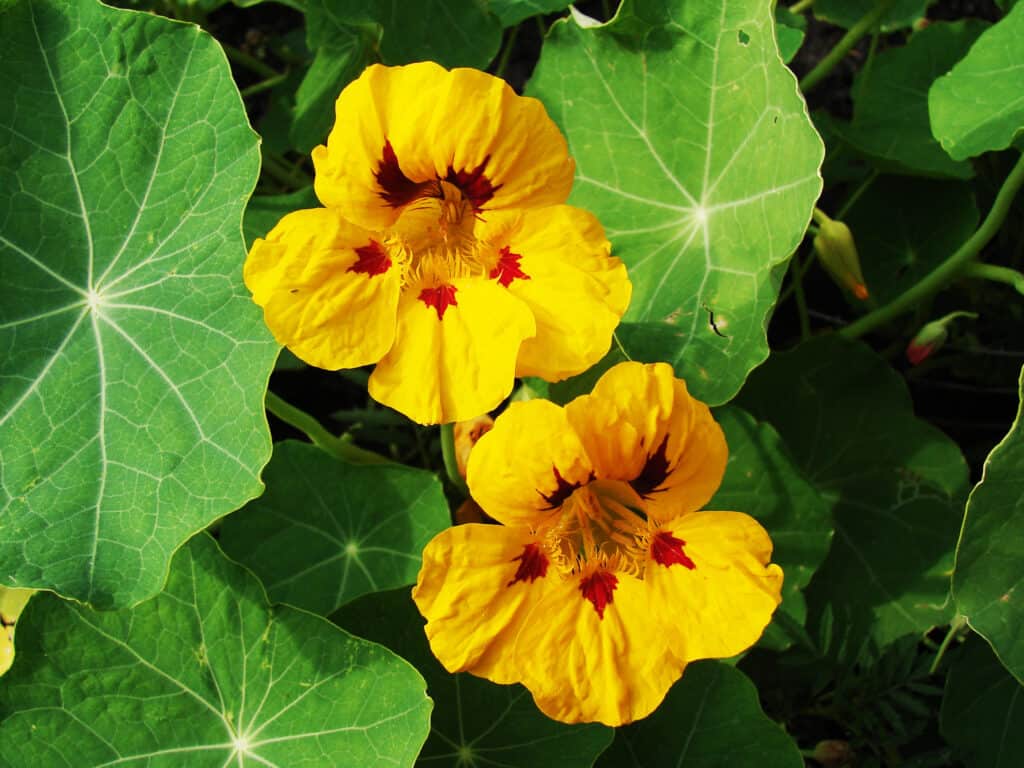
Nasturtiums are climbers that can reach up to 10 feet tall.
©Minos23/Shutterstock.com
Botanical name: Tropaeolum majus
Common names: Nasturtium, Indian cress, Mexican cress
USDA hardiness zones: 2 to 11
Sun exposure: Full sun
Mature size: Up to 10 feet tall, 3 feet wide
Bloom time: Summer to fall
Flower colors: Yellow, orange, red, cream, mahogany
Nasturtium flowers have a peppery or mustard-like scent that sends deer in the opposite direction! The mustard oil in their buds attracts butterflies, but deer want nothing to do with this smell or taste.
These low-maintenance deer-resistant annual flowers are great for beginner gardeners and perfect for adding a pop of lovely color to your landscape. This annual flower’s showy, round blooms are funnel-shaped and grow up to 3 inches across.
Be aware that nasturtiums are climbers that can reach up to 10 feet tall unless you grow the dwarf varieties. Plant climbing varieties near fences, pergolas, arbors, and trellises for vertical garden interest.
Quick tips for growing nasturtium:
- Watering needs: give nasturtium plants around 1 inch of water per week, watering again before the soil gets too dry.
- Maintenance: don’t fertilize nasturtiums because fertilizer tends to make them bloom less
- Garden pests: aphids, leaf hoppers, and flea beetles are common pests
- Common diseases: nasturtiums might develop aster yellows, leaf spot, downy mildew, or powdery mildew.
7. Poppy
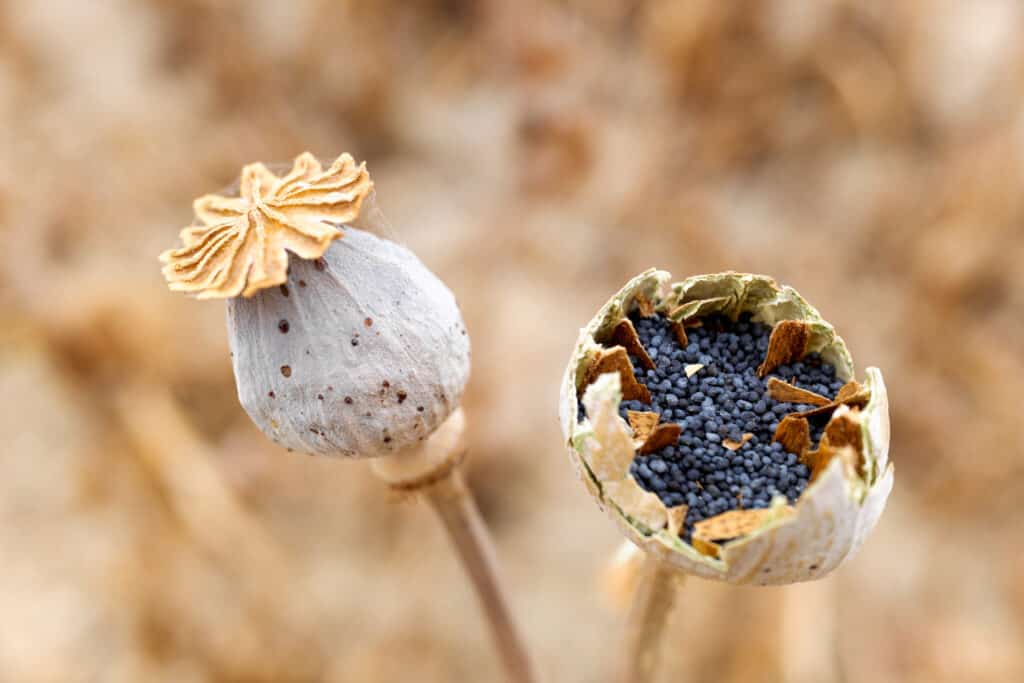
Poppy produces a milky sap toxic to deer.
©Joaquin Corbalan P/Shutterstock.com
Botanical name: Papaver somniferum
Common names: Poppy, breadseed poppy, opium poppy
USDA hardiness zones: 3 to 8
Sun exposure: Full sun
Mature size: Up to 3 feet tall, 1 foot wide
Bloom time: Summer
Flower colors: Purple, pink, orange, red, white
Poppies are deer-resistant annual flowers that come in various colors and shapes. They’re relatively easy to grow and make a dramatic statement in any garden bed or container.
Poppies produce large, cup-shaped blooms on top of slender stems. This plant’s flowers don’t last long, but new buds quickly replace them, so they always look fresh through summer.
Poppies are a favorite of bees and other pollinators, but deer tend to avoid them. The plants produce a milky sap that can be irritating and toxic to deer, so they’ll usually steer clear of any garden beds that contain these vibrant flowers.
Quick tips for growing poppies:
- Watering needs: poppies need moist and well-drained soil.
- Maintenance: your poppies don’t require much maintenance, although you may want to remove the spent blooms to prevent self-seeding.
- Garden pests: aphids could become an issue for poppy plants.
- Common diseases: poppies are relatively disease resistant, but they can develop powdery mildew if the foliage remains too wet.
8. Salvia
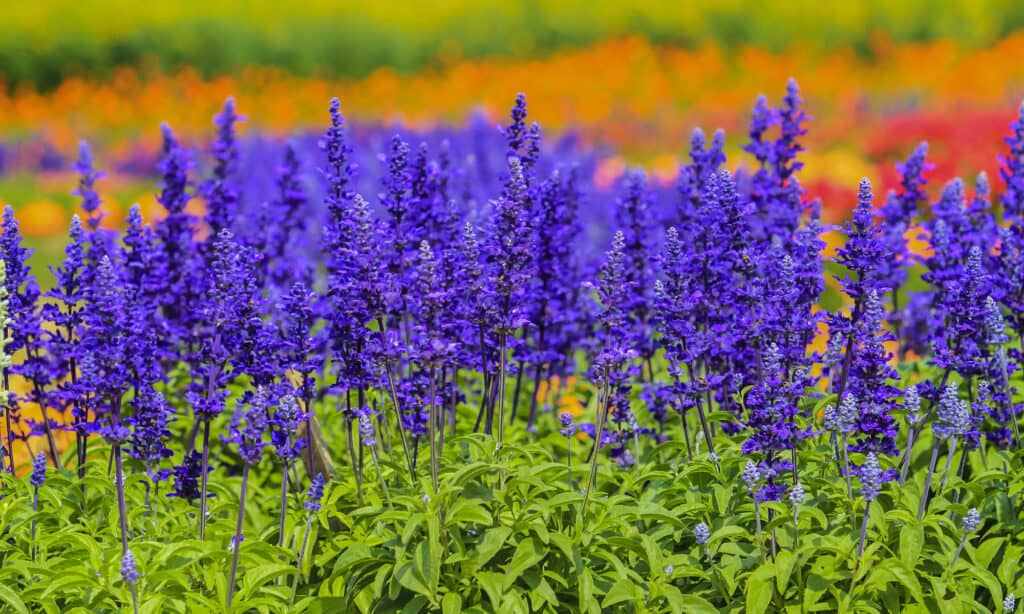
Deer dislike the smell of salvia.
©TuiPhotoEngineer/Shutterstock.com
Botanical name: Salvia farinacea
Common name: Mealycup sage, blue sage, blue salvia
USDA hardiness zones: 8 to 10
Sun exposure: Full sun or partial sun
Mature size: Up to 36 inches tall and 24 inches wide
Bloom time: Mid-spring to fall
Flower colors: Blue, lavender, purple, white
Salvia is an excellent choice for deer-resistant flower gardens because of this plant’s strong smell. Fortunately, deer dislike the smell of sage, so they’ll usually steer clear of any garden beds that contain these colorful spike flowers.
An easy-to-grow ornamental flower, salvia plants grow in clumps with multiple flowering spikes. The plants grow upright but larger, and leggy plants eventually topple over if not cut back for a second or third flowering during the growing season.
Blue and lavender salvia flowers look similar to lavender plants. And, also like lavender, salvia flowers last a long time in the garden and in flower arrangements.
Quick tips for growing salvia:
- Watering needs: drought-tolerant salvia prefers slightly moist soil, and overwatering will make the plants leggy.
- Maintenance: cut back salvia plants after their first bloom by at least 50% to promote a second flowering.
- Garden pests: slugs, snails, and spider mites like to eat salvia leaves.
- Common diseases: salvia might develop powdery mildew.
9. Snapdragon
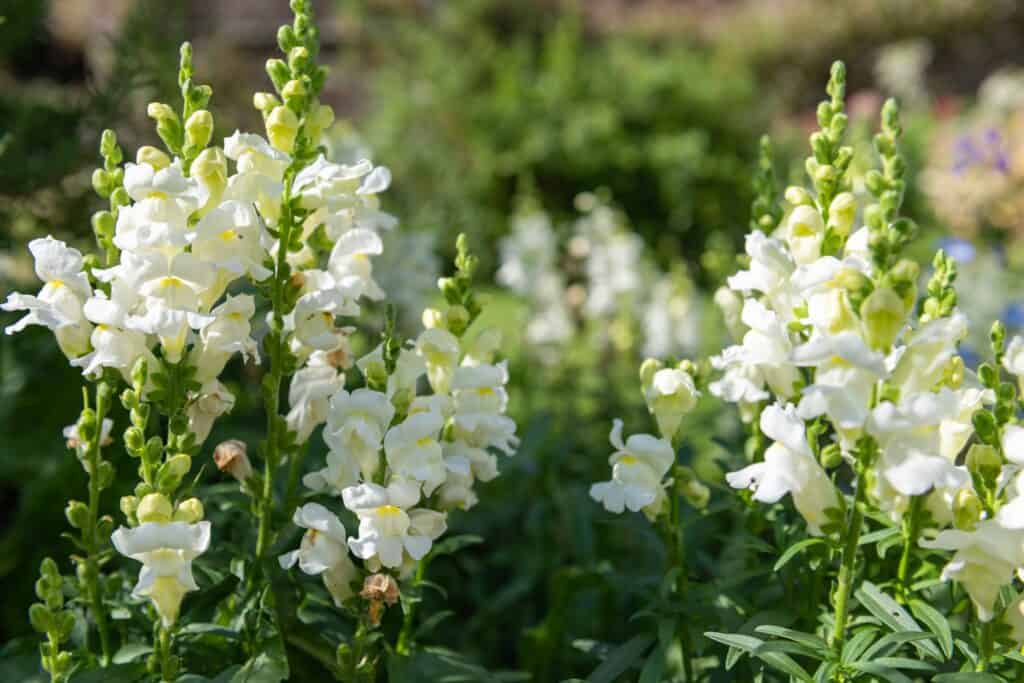
Snapdragons are showy garden beauties.
©Tom Meaker/Shutterstock.com
Botanical name: Antirrhinum majus
Common names: Snapdragon
USDA hardiness zones: 5 to 10
Sun exposure: Full sun
Mature size: Up to 36 inches tall, 18 inches wide
Bloom time: Spring to fall
Flower colors: White, pink, purple, red, yellow, orange
Though not considered toxic to animals, Snapdragons are deer-resistant annual flowers because they’re fragrant and don’t taste very good. Even better, snapdragons are showy garden beauties with their delicate orchid-like blooms bursting along their tall spikes. So plant as many snapdragons as you please in containers and cutting gardens to enjoy in summer flower arrangements.
Snapdragons are perennials in higher/warmer zones and grow as annuals in colder zones. And because snapdragons grow up to 36 inches tall, it’s essential to stake them to keep these spike flowers growing upright.
Quick tips for growing snapdragons:
- Watering needs: water near the roots and give your snapdragons about an inch of water per week.
- Maintenance: well-balanced fertilizer (10-10-10) should be applied to plants when they first begin to bloom.
- Garden pests: watch for spider mites and aphids.
- Common diseases: fungal mold, leaf spot, and downy mildew are common with snapdragons.
10. Tall Verbena
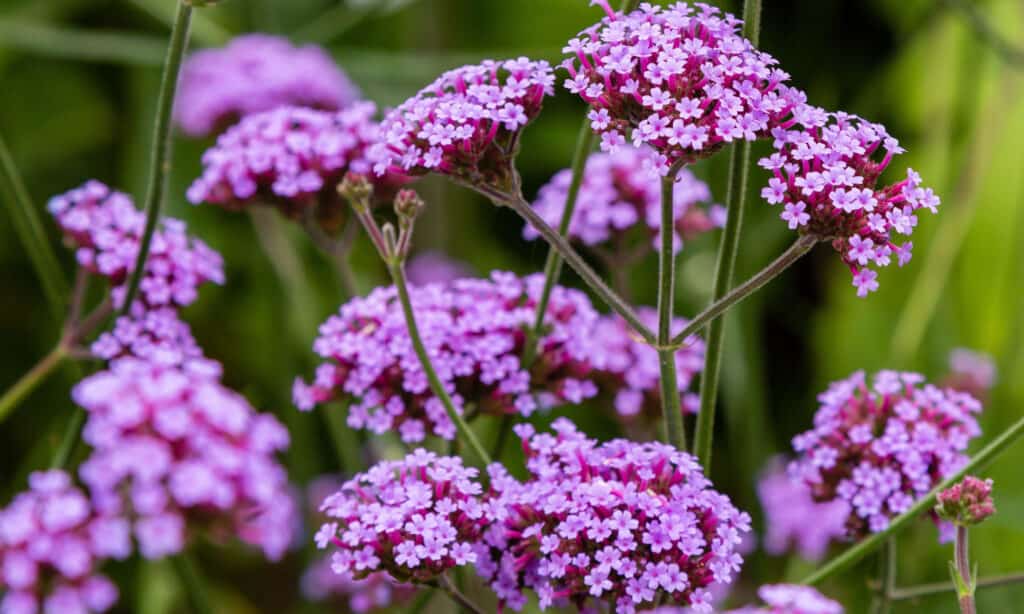
Verbena is fragrant and full of nectar.
©Flower_Garden/Shutterstock.com
Botanical name: Verbena bonariensis
Common names: Tall verbena, purpletop vervain, upright verbena
USDA hardiness zones: 7 to 11
Sun exposure: Full sun
Mature size: 3 to 6 feet tall, up to 3 feet wide
Bloom time: Early summer to fall
Flower colors: Lavender, purple, white
Tall verbena is a deer-resistant tender perennial grown as an annual flower in hardiness zones below 7-11. This variety of verbena is very fragrant and full of nectar, which is why deer don’t eat it, and pollinators love it!
Fragrant tall verbena grows clusters of tiny lavender flowers on the very top of their tall (up to 6 feet high!) slender stems. While the blooms are small, they attract bees, butterflies, and hummingbirds to the garden.
Quick tips for growing verbena:
- Watering needs: once a week should be sufficient unless there’s a prolonged dry spell.
- Maintenance: deadhead spent flower clusters to encourage more blooming.
- Garden pests: aphids, leaf miners, spider mites, and whiteflies are common verbena pests.
- Common diseases: grey mold and powdery mildew are common fungi diseases with verbena plants.
11. Zinnia
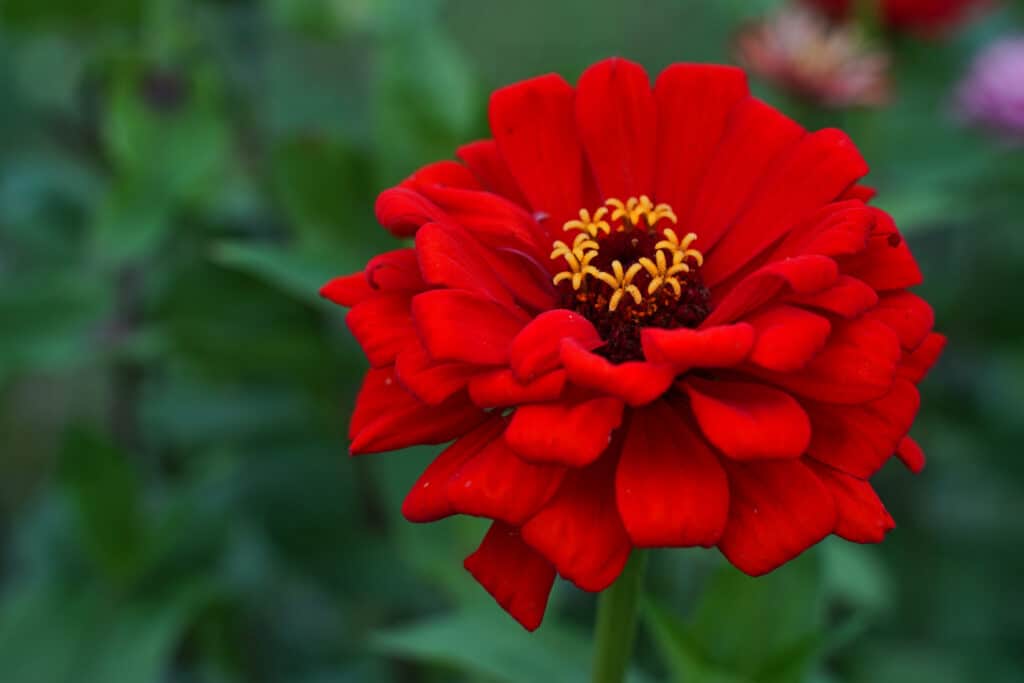
Deer as well as rabbits don’t find zinnia edible.
©iStock.com/Kathy Reasor
Botanical name: Zinnia elegans
Common names: Zinnia, common zinnia, elegant zinnia
USDA hardiness zones: 2 to 11
Sun exposure: Full sun
Mature size: 1 to 4 feet tall, 1 foot wide
Bloom time: Summer through fall
Flower colors: Red, pink, purple, white, orange, yellow, bi-color
Zinnias are an excellent choice for a deer-resistant annual flower because they don’t have a pleasing taste for hungry wild animals. But deer aren’t the only ones who don’t like zinnias — these flowers are also resistant to rabbits! So plant zinnias with confidence that they’ll provide color in your garden all season long.
Zinnia flowers grow on tall stalks with blooms similar in shape and style to daisies. Beautiful zinnias come in many colors and cultivars, making them a versatile choice for any garden. They are hardy flowers perfect for cutting gardens and arrangements with long-lasting blooms.
Quick tips for growing zinnias:
- Watering needs: mature zinnias can rot pretty quickly with overwatering, so water the plants when the soil is dry to the touch.
- Maintenance: Remove old blooms (deadhead) often and harvest your zinnias regularly to promote more plant growth.
- Garden pests: whiteflies, aphids, and spider mites might damage zinnia plants.
- Common diseases: aster yellows, blight, leaf spot, and powdery mildew are common fungal conditions for zinnias.
Deer-Resistant Garden Tips
How can you garden to make your flowers less appealing to deer? As any gardener knows, deer can be a big problem when it comes to flowers and plants. They love to eat them and can quickly decimate a garden. So if you’re looking for ways to make your flowers less appealing to deer, here are a few tips to help you out.
- One way to deter deer from your garden is to use strong scents. Scatter citrus peels, garlic, or hot peppers around plants to discourage deer and other animals from coming near.
- Another way to keep deer away is to make your garden less appealing to them. Grow flowers that deer don’t like to eat or plant them in a way that makes them less accessible. You can also try using deer repellent on plants to make them less appealing to hungry deer.
- Fencing and other barriers like black mesh also help keep deer out of your garden. Garden mesh is readily available, easy to install, and deer don’t like to jump over it or crawl through it.
No matter what method you choose, it’s important to stay vigilant and keep on top of any deer problems that may arise. Following these tips can help keep your flowers safe from those pesky deer.
Deer-Resistant Annual Flowers Keep Garden Beds Safer From Many Animals
If deer don’t like eating your plants, it’s pretty likely that other animals, like rabbits and groundhogs, won’t be interested in eating them either. So plant the easy-to-grow annual flowers from our list and enjoy far less plant loss in your garden from deer and other hungry wild animals.
Summary of 11 Deer-Resistant Annual Flowers
Here’s a recap of 11 annual flowers that repel deer due to their spicy or bitter taste, strong aroma, toxicity, texture and more:
| Number | Flower | Deer-Resistance Reason |
|---|---|---|
| 1 | African Marigold | Strong citrus scent |
| 2 | Ageratum | Scent |
| 3 | Canna Lily | Challenging to chew |
| 4 | Chrysanthemum | Scent |
| 5 | Love-in-a-Mist | Deer avoid this plant |
| 6 | Nasturtium | Peppery or mustard-like scent |
| 7 | Poppy | Produce a milky sap irritating and toxic to deer |
| 8 | Salvia | Strong scent |
| 9 | Snapdragon | Scent and unpleasant taste |
| 10 | Tall Verbena | Strong scent and full of nectar |
| 11 | Zinnia | Unpleasant taste |
The photo featured at the top of this post is © TuiPhotoEngineer/Shutterstock.com
Sources
- University of Minnesota, Available here: https://extension.umn.edu/garden/yard-garden/landscaping/deer-resistant-perennials/
- North Carolina State University, Available here: https://plants.ces.ncsu.edu/plants/canna-x-generalis/
- Missouri Botanical Garden, Available here: https://www.missouribotanicalgarden.org/PlantFinder/PlantFinderDetails.aspx?kempercode=a618
Thank you for reading! Have some feedback for us? Contact the AZ Animals editorial team.






